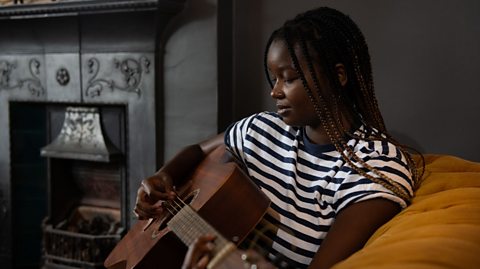The White Stripes launching into Seven Nation Army.
Franz Ferdinand electrifying the venue with the moment everyoneâs waiting for in Take Me Out, or Nile Rodgersâ contribution to Daft Punkâs Get Lucky. They all have one thing in common: riffs.
A guitar riff is the hook of a song. Itâs a sequence of notes and chords that gives a track an identity. It can open a song, and be repeated throughout as a distinctive motif. The journalist and music critic Greg Lot once said: âA riff, when done right, can shape a song and often rule it.â

The first influential guitar riff in mainstream pop is considered by many musicians to come from Chuck Berryâs Johnny B. Goode, released in 1958. In a 2014 ±«Óătv Four documentary, Queen guitarist Brian May said: âI donât think thereâs a guitarist alive who honestly could say they werenât influenced by Chuck Berry.â
But how do you make a riff memorable? ±«Óătv Bitesize enlisted the help of guitar tutors Tolis Zavaliaris and Bobby Harrison of Londonâs Institute of Contemporary Music Performance. They shared their years of teaching and performing experience to offer the following advice.
Simple means catchy
Riffs werenât born at the same time as rock ânâ roll. Theyâve been around for centuries. The opening of Mozartâs Eine Kleine Nachtmusik, written in 1787, is a good example of a riff (or motif) that remains popular more than 200 years later. It identifies the piece straight away and adds to its cultural staying power.

Many guitar riffs that feature on âbest ofâ lists contain a two to four bar repeating motif.
Theyâre catchy because theyâre easy to sing or hum along to and have a habit of not leaving our brains, even when we want them to (becoming whatâs known as an earworm). An example of this kind of riff, suggested by Bobby, is The White Stripesâ Seven Nation Army, mentioned earlier.
Hand me the keys, plug in the power
A key in music is a scale which forms the basis of a tune.
In guitar, the âfriendlyâ keys are seen as E, A, G and D. These keys allow a guitarist to include what are known as open strings in their playing. They feel clear, have a powerful sound, and are used a lot in songwriting.

Power cords may be what we use to plug the TV in at the wall. Power chords, on the other hand, are an excellent building block in the creation of a guitar riff.
Bobby explained: âPower chords feature heavily in many classic guitar riffs.
âContrary to what the name suggests, these chords are made of up just two different notes. Despite usually being played on two or three strings, power chords can create a huge sound when effects such as overdrive or distortion (to change the tone) are added to the guitarâs signal.â
Keen to hear some power chords? The riff on Green Dayâs American Idiot is a fine example recommended by Bobby.

The technical side
Want to create a memorable riff? These are just some of the elements and techniques youâll need to know to wake up a guitarâs potential.
Intervals: The distance between notes on a guitarâs fretboard (it applies to other instruments too). This can be a complex topic to get your plectrum around, involving major and minor notes, such as a major third and a perfect fifth. Itâs worth persevering, these are key to building a riff.
Octaves: Tolis explained that the intervals we hear most in modern songwriting happen within the octave. Thatâs the gap between notes of the same name. For example, play an A note on your guitar, and the gap either up or down the fretboard to the next A note is an octave. That next A along will be either an octave higher or lower than the first one you played. Thereâs eight notes between octaves, which is how they got their name.
Triads: A major scale on a guitar has a sequence of notes. For example, the G major scale is G-A-B-C-D-E-F sharp. If you played G, B and D at the same time, you would be playing a chord known as a triad - a group of notes that are a third apart from each other (G to B is three notes, B to D is three notes). Moving from one triad to another in composition is popular.

Blue is a popular pattern
As a guitarist immerses themselves in the technical side of playing, and looks at how others do it, itâs possible to see some practices that keep on appearing.
There are many kinds of scale in guitar. Get to know the minor pentatonic scale (made up of five notes) and blues scale (made up of six notes) and youâll be well on the way to writing riffs which sit well alongside other pop classics.
Classic riffs, from groups including Fleetwood Mac and Led Zeppelin, have been written in these scales. The blues had a big influence on rock ânâ roll and many of its harmonic ingredients lived on in the rock and pop of the 1960s and 1970s.

Rhythm is a riffer
Itâs not just the notes, the bits in between them are important too.
Those gaps help build the rhythm in a riff, creating a groove that the composition falls in to. Itâs the pattern of long and short sounds that gives the song a feeling, for both the guitarist and the listener - it could even make you want to dance.
An example of this is the introduction to Aerosmithâs Walk This Way. The spaces between the notes, Bobby says, are: âalmost as powerful as the notes played,â and help give the song its distinctive personality.
But the technical aspects will only get you so far. Creating a riff that lives in the memory also means putting a guitar in the hands of an artist.
Take one innovative, competitive musician
Tolis says the sort of musician who keeps learning and stays open to new ideas is more likely to create something memorable.
This meant absorbing new influences, including blues, jazz, and traditional sounds from other countries - such as the Indian stylings which can be heard in The Beatlesâ Here Comes the Sun. This song features changes in time signature (the number of beats in a bar), a feature of Indian classical music, which was an influence on composer George Harrison at the time he wrote it.
âThe more you research,â Tolis said, âthe more you progress to the next level.â
So, before taking a deep dive into the technical aspects, consider opening yourself up to as many influences as possible, donât be afraid to experiment with different styles, work out your rhythm, strum a few power chords on the blues scale, be your own musician - and who knows what riff-based magic could follow?
Classical music is everywhere in pop culture if you look hard enough.

Five potential health benefits of music
For those who need more evidence of why music's so great.

When classical music was punk
What some composers went through would have The Sex Pistols quaking.
